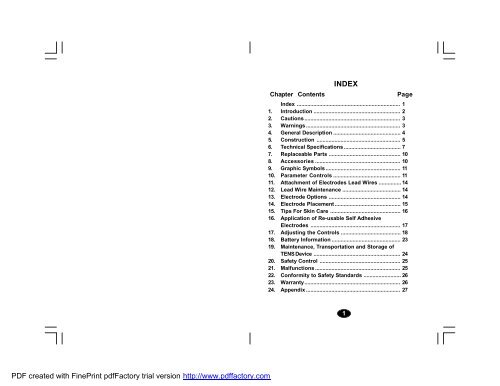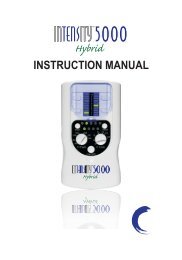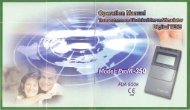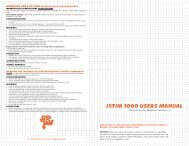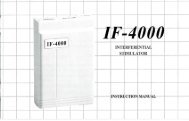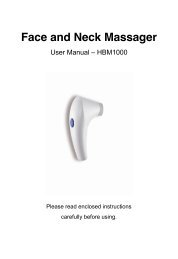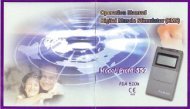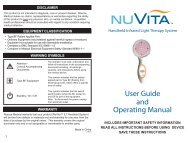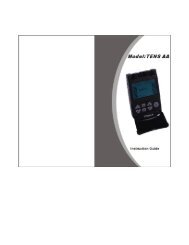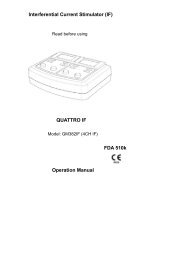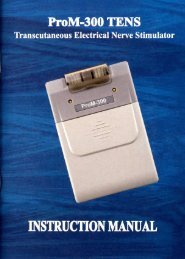TENS EV-803P Manual - Current Solutions LLC
TENS EV-803P Manual - Current Solutions LLC
TENS EV-803P Manual - Current Solutions LLC
You also want an ePaper? Increase the reach of your titles
YUMPU automatically turns print PDFs into web optimized ePapers that Google loves.
INDEX<br />
Chapter Contents Page<br />
Index ..................................................................... 1<br />
1. Introduction .......................................................... 2<br />
2. Cautions ................................................................ 3<br />
3. Warnings ............................................................... 3<br />
4. General Description ............................................. 4<br />
5. Construction ........................................................ 5<br />
6. Technical Specifications ...................................... 7<br />
7. Replaceable Parts ................................................ 10<br />
8. Accessories ......................................................... 10<br />
9. Graphic Symbols .................................................. 11<br />
10. Parameter Controls ............................................. 11<br />
11. Attachment of Electrodes Lead Wires ............... 14<br />
12. Lead Wire Maintenance ....................................... 14<br />
13. Electrode Options ................................................ 14<br />
14. Electrode Placement ............................................ 15<br />
15. Tips For Skin Care ............................................... 16<br />
16. Application of Re-usable Self Adhesive<br />
Electrodes ............................................................ 17<br />
17. Adjusting the Controls ........................................ 18<br />
18. Battery Information .............................................. 23<br />
19. Maintenance, Transportation and Storage of<br />
<strong>TENS</strong> Device .......................................................... 24<br />
20. Safety Control ...................................................... 25<br />
21. Malfunctions ......................................................... 25<br />
22. Conformity to Safety Standards ......................... 26<br />
23. Warranty................................................................ 26<br />
24. Appendix ............................................................... 27<br />
1<br />
PDF created with FinePrint pdfFactory trial version http://www.pdffactory.com
EXPLANATION OF PAIN<br />
Chapter 1: INTRODUCTION<br />
Pain is a warning system and the body ’s method of telling us that<br />
something is wrong. Pain is important; without it abnormal conditions<br />
may go undetected, causing damage or injury to vital parts of our<br />
bodies.<br />
Even though pain is a necessary warning signal of trauma or<br />
malfunction in the body, nature may have gone too far in its design.<br />
Aside from its value in diagnosis, long-lasting persistent pain serves<br />
no useful purpose. Pain does not begin until a coded message<br />
travels to the brain where it is decoded, analyzed, and then reacted<br />
to. The pain message travels from the injured area along the small<br />
nerves leading to the spinal cord. Here the message is switched to<br />
different nerves that travel up the spinal cord to the brain. The pain<br />
message is then interpreted, referred back and the pain is felt.<br />
EXPLANATION OF <strong>TENS</strong><br />
Transcutaneous Electrical Nerve Stimulation is a non-invasive, drugfree<br />
method of controlling pain. <strong>TENS</strong> uses tiny electrical impulses<br />
sent through the skin to nerves to modify your pain perception.<br />
<strong>TENS</strong> does not cure any physiological problem; it only helps control<br />
the pain. <strong>TENS</strong> does not work for everyone; however, in most<br />
patients it is effective in reducing or eliminating the pain, allowing for<br />
a return to normal activity.<br />
HOW <strong>TENS</strong> WORKS<br />
There is nothing “magic” about Transcutaneous Electrical Nerve<br />
Stimulation (<strong>TENS</strong>). <strong>TENS</strong> is intended to be used to relieve pain. The<br />
<strong>TENS</strong> unit sends comfortable impulses through the skin that stimulate<br />
the nerve (or nerves) in the treatment area. In many cases, this<br />
stimulation will greatly reduce or eliminate the pain sensation the<br />
patient feels. Pain relief varies by individual patient, mode selected<br />
for therapy, and the type of pain. In many patients, the reduction or<br />
2<br />
elimination of pain lasts longer than the actual period of stimulation<br />
(sometimes as much as three to four times longer). In others, pain is<br />
only modified while stimulation actually occurs. You may discuss<br />
this with your physician or therapist.<br />
Chapter 2: CAUTIONS<br />
1. Read operation manual before use of <strong>TENS</strong>.<br />
2. We emphasize that patient with an implanted electronic device<br />
(for example, a pacemaker) should not undergo <strong>TENS</strong> treatment<br />
without first consulting a doctor. The same applies to patients<br />
with any metallic implants.<br />
3. If <strong>TENS</strong> therapy becomes ineffective or unpleasant, stimulation<br />
should be discontinued until its use is reevaluated by the physician<br />
or therapist.<br />
4. Avoid adjusting controls while operating machinery or vehicles.<br />
5. Turn the T.E.N.S. off before applying or removing electrodes.<br />
6. The T.E.N.S. devices have no AP/APG protection.<br />
Do not use it in the presence of explosive atmosphere and<br />
flammable mixture.<br />
Chapter 3 : WARNINGS<br />
1. Caution should be used in applying <strong>TENS</strong> to patients suspected<br />
of having heart disease. Further clinical data is needed to show<br />
there are no adverse results.<br />
2. Electrical stimulation safety has not been established during<br />
pregnancy.<br />
Do not use <strong>TENS</strong> during pregnancy.<br />
3. Do not place electrodes on the front of the throat as spasm of the<br />
Laryngeal and Pharyngeal muscle may occur. Do not stimulate<br />
over the carotid nerve, particularly with patients with known<br />
sinus reflex sensitivity.<br />
4. Care should be taken so that when operating potentially<br />
dangerous machinery the stimulator controls are not changed<br />
abruptly.<br />
3<br />
PDF created with FinePrint pdfFactory trial version http://www.pdffactory.com
5. Cases of skin irritation at the electrode site have been reported.<br />
Stimulation should be stopped and electrodes removed until the<br />
cause of the irritation can be determined.<br />
6. Electrodes should not be placed over the eyes, in the mouth, or<br />
internally.<br />
7. Keep this device out of the reach of children.<br />
Chapter 5 : CONSTRUCTION<br />
FRONT<br />
SIDE(RIGHT)<br />
Chapter 4 : GENERAL DESCRIPTION<br />
The <strong>EV</strong>-<strong>803P</strong> DIGITAL T.E.N.S. is a battery operated pulse generator<br />
that sends electrical impulses electrodes to the body and reach the<br />
nerves causing pain. The device is provided with two controllable<br />
output channels, each independent of each other. An electrode pair<br />
can be connected to each output channel.<br />
The electronics of the <strong>EV</strong>-<strong>803P</strong> DIGITAL <strong>TENS</strong> create electrical<br />
impulses whose Intensity, duration, number per second, timer and<br />
modulation may be altered with the controls/buttons. Nine preset<br />
programs are available for option as well. Press buttons are very<br />
easy to use and the large liquid crystal display showing the exact<br />
mode and values of parameters are very convenient for patients.<br />
(1) POWER ON/OFF SWITCH<br />
(2) LEAD CONNECTOR<br />
(3) IN<strong>TENS</strong>ITY CONTROL<br />
(4) LCD<br />
(5) PULSE WIDTH CONTROL<br />
(6) MODE CONTROL<br />
(7) PULSE RATE CONTROL<br />
(8) TIMER CONTROL<br />
(9) BATTERY STRIP<br />
(10) BATTERY CASE<br />
4<br />
5<br />
PDF created with FinePrint pdfFactory trial version http://www.pdffactory.com
BACK<br />
SIDE(LEFT)<br />
Chapter 6 : TECHNICAL SPECIFICATIONS<br />
(10) METAL BELT CLIP<br />
(11) PROGRAM LOCK BUTTON<br />
LIQUID CRYSTAL DISPLAY (MODE N, M)<br />
LIQUID CRYSTAL DISPLAY (MODE B)<br />
6<br />
(1) AMPLITUDE VALUE<br />
(2) MODE<br />
(3) PULSE RATE<br />
(4) PULSE WIDTH<br />
(5) TIMER<br />
(6) LOCK<br />
(1) BURST RATE<br />
LIQUID CRYSTAL DISPLAY (MODE P )<br />
(1) PROGRAM NUMBER<br />
(2) TIMER<br />
The technical specification details of <strong>EV</strong>-<strong>803P</strong> DIGITAL T.E.N.S. are<br />
as follows.<br />
MECHANISM<br />
TECHICALDESCRIPTION<br />
01 Channel Dual, isolated between channels<br />
02 Pulse Amplitude Adjustable 0-80mA, Max output 80mA<br />
peak to peak (15.8mA rms) into 500ohm<br />
load each channel, 1mA each step.<br />
03 Output Voltage Adjustable 0-40V, Max output 40V peak<br />
to peak (8.5V rms) into 500ohm load<br />
each channel.<br />
04 Wave Form Asymmetrical rectangular biphasic<br />
pulse.<br />
05 Power Supply One 9 Volt Battery, type 6F22<br />
06 Size 10.1cm(L) x 6.8cm(W) x 2.15cm(H)<br />
07 Weight 155 grams (battery included)<br />
08 Pulse Rate Adjustable, 1~150Hz , 1Hz / step<br />
09 Pulse Width Adjustable, 50~300µs , 10µs / step<br />
10 Mode Four modes available, B(Burst), N<br />
(Normal) , M(Pulse Rate Modulation)<br />
and P(Program). Parameters are<br />
adjustable at B, N or M mode.<br />
Nine pre-set programs (fixed) are<br />
available of options at P mode. (Pulse<br />
Width Modulation and Mixed<br />
Frequency are included.)<br />
11 Burst Burst rate adjustable, 0.5~5 Hz<br />
Pulse width adjustable, 50~300µs<br />
Frequency fixed = 100Hz<br />
12 Normal Constant output based on the setting<br />
value.<br />
13 P.R. Modulation(-40%) Pulse rate is automatically varied in a<br />
cyclic pattern over an interval of<br />
nominally 10 seconds. (in max 150Hz)<br />
Pulse rate decreases linearly over a<br />
7<br />
PDF created with FinePrint pdfFactory trial version http://www.pdffactory.com
period of 5 seconds from the control setting<br />
value to a value which is 40% less. Then<br />
increase linearly over a 5 seconds period<br />
to its original value. The cycle is then<br />
repeated.<br />
14 Timer Selectable, 30 Minutes, 60 Minutes or<br />
Continue.<br />
15 Program The pre-set parameters of the 9<br />
Details<br />
programs are as given below:<br />
Program Mode Pulse Rate Pulse Width Timer<br />
P1 Constant 80Hz 180µs Continue<br />
16 Program Lock The intensity and the value of all parameters<br />
will be locked when the “Lock” button is<br />
pressed.<br />
17 Operating Temperature:0°~40℃<br />
Condition Relative Humidty:30%~75%<br />
Atmosphere Pressure : 700Hpa~1060Hpa<br />
18 Remark There may be up to a +/-5% tolerance of all<br />
parameters and +/-20% tolerance of<br />
amplitude & voltage.<br />
P2 Burst 100Hz 180µs Continue<br />
(Burst Rate:2Hz)<br />
P3 -70% P.W. 80Hz 50µs -180µs Continue<br />
Modulation<br />
P4 Mixed 15Hz in 3 Sec / 180µs Continue<br />
Frequency 2Hz in 3 Sec<br />
P5 Mixed 80Hz in 3 Sec / 180µs Continue<br />
Frequency 2Hz in 3 Sec<br />
P6 Constant 10Hz 180µs Continue<br />
P7 Constant 80Hz 60µs Continue<br />
P8 Constant 80 Hz 180µs 30 Minutes<br />
P9 Burst 100Hz 180µs 30 Minutes<br />
(Burst Rate:2Hz)<br />
8<br />
9<br />
PDF created with FinePrint pdfFactory trial version http://www.pdffactory.com
Chapter 7: REPLACEABLE PARTS<br />
PARTS<br />
01 LEAD WIRES<br />
02 ELECTRODES<br />
03 9V BATTERY, TYPE 6F22<br />
04 BELT CLIP<br />
05 BATTERY CASE COVER<br />
06 LEAD CONNECTOR<br />
08 MAIN PCB<br />
09 IN<strong>TENS</strong>ITY KNOB<br />
Chapter 8: ACCESSORIES<br />
Each set <strong>EV</strong>-<strong>803P</strong> DIGITAL T.E.N.S. are completed with standard<br />
accessories and standard label as given below<br />
I. Accessories<br />
REF. NO. DESCRIPTION Q’TY<br />
1. KS4040 40 X 40 MM Adhesive Electrodes 4 pieces<br />
2. KE-26 Electrodes Leads 2 pieces<br />
3. GC-01 9 V Battery, type 6F22 1 piece<br />
4. Instruction <strong>Manual</strong> 1 piece<br />
5. Carrying Case 1 piece<br />
II. LABEL<br />
The label attached to the back of<br />
device contains important message<br />
about this device- model, serial<br />
number, supply voltage, the name of<br />
manufacturer, CE number and<br />
classification. Please do not remove.<br />
10<br />
Chapter 9 : GRAPHIC SYMBOLS<br />
1. Note Operating Instructions<br />
2. Degree of Electrical Protection BF<br />
3. Do not insert the plug into AC power supply socket.<br />
4. Pulse Rate<br />
5. Pulse Width<br />
6. Increase<br />
7. Decrease<br />
8. Program is Locked<br />
9. Timer<br />
Chapter 10 : PARAMETER CONTROLS<br />
PULSE DURATION<br />
Wider pulse duration settings will deliver stronger stimulation for any<br />
given intensity setting. As mentioned in the Controls section, by<br />
using a combination of intensity and pulse duration, it is felt that<br />
various pulse widths are capable of stimulating different groups of<br />
nerve fibres.<br />
The wider pulse duration is needed to recruit motor fibres, whereas<br />
the narrow pulse duration is used on the more sensory fibres.<br />
The choice of which pulse duration to use is partially dependent<br />
upon the Treatment Mode and Protocol selected (refer to the<br />
appropriate section).<br />
11<br />
PDF created with FinePrint pdfFactory trial version http://www.pdffactory.com
PULSE RATE<br />
The Pulse Rate (hertz or pulses per second) chosen depends greatly<br />
upon the type of electrode placement given to the patient.<br />
When using contiguous and dermatome electrode placements (i.e.<br />
stimulating directly through the area of pain or localized enervation),<br />
a quick pulse rate (setting greater than 80Hz on the Pulse Rate<br />
Control) is desired. The patient should not perceive individual pulses<br />
but rather have the sensation of steady continuous stimulation.<br />
When using point treatments, it has been suggested that slow pulses<br />
be utilized (less than 10Hz). With this setting the patient should be<br />
able to slightly perceive individual pulses.<br />
When using multiple electrode placement strategies, such as<br />
combinations of point and contiguous electrode placements, the<br />
quicker pulse rates are suggested.<br />
Despite above recommendations, these individual patients may<br />
require slight variations of the above settings, according to the nature<br />
of their condition.<br />
TREATMENT MODE<br />
Normal or Conventional <strong>TENS</strong> offers the practitioners complete control<br />
over all the various treatment parameters of the instrument.<br />
Burst Mode is analogous to the Low Rate <strong>TENS</strong> technique except the<br />
low frequency individual pulses are replaced by individual “bursts”<br />
of 7-10 individual pulses. It is thus a combination of Conventional<br />
<strong>TENS</strong> and Low Rate <strong>TENS</strong>. In Burst Mode, the treatment frequency<br />
is adjustable at the range between 0.5Hz – 5Hz.<br />
Modulated Mode attempts to prevent nerve accommodation by<br />
continuously cycling the treatment intensity. When using Modulated<br />
Mode increase the intensity only when the unit is at the maximum<br />
intensity of the modulation cycle. If the intensity is increased during<br />
a low intensity period of the cycle, the patient may turn up the control<br />
very slowly, so that they may feel the intensity any higher.<br />
12<br />
IN<strong>TENS</strong>ITY<br />
Each patient responds differently to different levels of intensity, due<br />
to varying degrees of tissue resistance, enervation, skin thickness,<br />
etc. Intensity instructions are therefore limited to the following settings:<br />
Perception – The intensity is increased so that the patient can feel<br />
the stimulation, but there is not any muscular contraction.<br />
Slight Contraction – Intensity is increased to a barely visible muscular<br />
contraction that is not strong enough to move a joint. When using<br />
low pulse rate settings, this will show as individual twitches. At<br />
higher pulse rates there will simply be increased muscle tension.<br />
Strong muscular contraction is typically not used in <strong>TENS</strong> therapy.<br />
However, muscular contraction may be useful if the pain involves a<br />
cramped or spastic muscle.The <strong>TENS</strong> can be used as a traditional<br />
muscle stimulator in the circumstances to quickly break the spasm.<br />
Use a quick pulse rate, wide pulse duration and set the intensity to<br />
visible contraction (still within patient tolerance). Twenty or thirty<br />
minutes of such a tetanized muscular contraction will generally break<br />
the spasm. In all cases, if the patient complains that the stimulation is<br />
uncomfortable, reduce intensity and/or cease stimulation.<br />
TIME DURATION<br />
The onset of pain relief should occur shortly after the intensity setting<br />
has been determined. However, in some cases, pain relief may take<br />
as long as 30 minutes to achieve, especially when using point<br />
electrode placements and slow pulse rates.<br />
<strong>TENS</strong> units are typically operated for long periods of time, with a<br />
minimum of 20 – 30 minutes and in some post-operation protocols, as<br />
long as 36 hours.<br />
In general, pain relief will diminish within 30 minutes of the cessation<br />
of stimulation. Pain relief obtained through point electrode placements<br />
may last longer (perhaps because of the presence of endorphins).<br />
13<br />
PDF created with FinePrint pdfFactory trial version http://www.pdffactory.com
Chapter 11 : ATTACHMENT OF ELECTRODE LEAD<br />
WIRES<br />
The wires provided with the system insert into the jack sockets<br />
located on top of the device. Holding the insulated portion of the<br />
connector, push the plug end of the wire into one of the jacks (see<br />
drawing); one or two sets of wires may be used.<br />
After connecting the wires to the stimulator, attach each wire to<br />
an electrode. Use care when you plug and unplug the wires.<br />
Jerking the wire instead of holding the insulated connector body<br />
may cause wire breakage.<br />
CAUTION<br />
Do not insert the plug of the patient lead wire into the AC power<br />
supply socket.<br />
Chapter 14 : ELECTRODE PLACEMENT<br />
The placement of electrodes can be one of the most important<br />
parameters in achieving success with <strong>TENS</strong> therapy. Of utmost<br />
importance is the willingness of the clinician to try the various styles<br />
of electrode placement to find which method best fits the needs of<br />
the individual patient.<br />
Every patient responds to electrical stimulation differently and their<br />
needs may vary from the conventional settings suggested here. If<br />
the initial results are not positive, feel free to experiment. Once an<br />
acceptable placement has been achieved, mark down the electrodes<br />
sites and the settings on the patient’s Reference sheet of this manual,<br />
so the patient can easily continue treatment at home.<br />
CONTIGUOUS PLACEMENT<br />
This is the most common placement technique. It involves placing the<br />
electrodes alongside the area of localized pain site, in such a way<br />
as to direct the flow of current through or around the area of pain.<br />
In a single channel application, this would involve placing each pad<br />
on either side of the pain site if the pain is localized on a limb and<br />
deep within the tissue. Pad placement on the posterior and anterior<br />
aspects of the affected limb will allow the current to flow completely<br />
through the limb and thus through the endogenous pain site.<br />
Chapter 12: LEAD WIRE MAINTENANCE<br />
Clean the wires by wiping with a damp cloth. Coating them lightly<br />
with talcum powder will reduce tangling and prolong life.<br />
Chapter 13 : ELECTRODE OPTIONS<br />
Your clinician will decide which type of electrode is best for your<br />
condition. Follow application procedures outlined in electrode packing,<br />
to maintain stimulation and prevent skin irritation. Use of legally<br />
marketed Electrodes is recommended.<br />
14<br />
With a two channels application, the clinician may either direct the<br />
current flow to cross through the pain site or, in what is called the<br />
“bracket” method allowing the current flow on either side of the<br />
painful area, generally through the nerve branches that feed into the<br />
pain site.<br />
DERMATOMES, MYOTOMES AND SCLEROTOMES<br />
These are the regions of the body enervated by one spinal nerve.<br />
Electrode placement involves both stimulating across the similarly<br />
enervated area and/or placing one electrode (or set of electrodes)<br />
at the pain site and another electrode (set) at the point where the<br />
nerve root joins the spinal cord.<br />
15<br />
PDF created with FinePrint pdfFactory trial version http://www.pdffactory.com
MOTOR, TRIGGER AND ACUPUNCTURE POINTS<br />
While these points of high tissue conductivity can differ in location<br />
and in theory of use, their use as an electrode site is identical. The<br />
easiest technique involves placing one pad directly over the point<br />
and completing the circuit by placing the second pad on some area<br />
on the affected side. This second electrode site can be within a<br />
nerve zone, or a master point located between the thumb and the<br />
forefinger on the dorsal web area between the two metacarpal<br />
bones.<br />
MULTIPLE PLACEMENT STRATEGIES<br />
Because the <strong>TENS</strong> has two independently operated channels, the<br />
clinician may take advantage of concurrent pad placement strategies.<br />
For example, it is possible to use two different electrode placement<br />
strategies at the same time. One channel can be used to directly<br />
stimulate the pain site in a contiguous manner; the other channel can<br />
be placed along the involved dermatome or utilized for point therapy.<br />
Chapter 15 : TIPS FOR SKIN CARE<br />
To avoid skin irritation, especially if you have sensitive skin, follow<br />
these suggestions:<br />
1. Wash the area of skin where you will be placing the electrodes,<br />
using mild soap and water before applying electrodes, and after<br />
taking them off. Be sure to rinse soap off thoroughly and dry skin<br />
well.<br />
2. Excess hair may be clipped with scissors; do not shave stimulation<br />
area.<br />
3. Wipe the area with the skin preparation your clinician has<br />
recommended. Let this dry. Apply electrodes as directed.<br />
4. Many skin problems arise from the “pulling stress” from adhesive<br />
patches that are excessively stretched across the skin during<br />
application. To prevent this, apply electrodes from centre outward;<br />
avoid stretching over the skin.<br />
5. To minimize “pulling stress”, tape extra lengths of lead wires to<br />
the skin in a loop to prevent tugging on electrodes.<br />
16<br />
6. When removing electrodes, always remove by pulling in the<br />
direction of hair growth.<br />
7. It may be helpful to rub skin lotion on electrode placement area<br />
when not wearing electrodes.<br />
8. Never apply electrodes over irritated or broken skin.<br />
Chapter 16: APPLICATION OF RE-USABLE SELF<br />
Application<br />
ADHESIVE ELECTRODES<br />
1. Clean and dry the skin at the prescribed area thoroughly with<br />
soap and water prior to application of electrodes.<br />
2. Insert the lead wire into the pin connector on the pre-wired<br />
electrodes.<br />
3. Remove the electrodes from the protective liner and apply the<br />
electrodes firmly to the treatment site.<br />
Removal<br />
1. Lift at the edge of electrodes and peel; do not pull on the lead<br />
wires because it may damage the electrodes.<br />
2. Place the electrodes on the liner and remove the lead wire by<br />
twisting and pulling at the same time.<br />
Care and Storage<br />
1. Between uses, store the electrodes in the resealed bag in a cool<br />
dry place.<br />
2. It may be helpful to improve repeated application by spreading a<br />
few drops of cold water over the adhesive and turn the surface<br />
up to air dry. Over Saturation with water will reduce the adhesive<br />
properties.<br />
17<br />
PDF created with FinePrint pdfFactory trial version http://www.pdffactory.com
Important<br />
1. Do not apply to broken skin.<br />
2. The electrodes should be discarded when they are no longer<br />
adhering.<br />
3. The electrodes are intended for single patient use only.<br />
4. If irritation occurs, discontinue use and consult your clinician.<br />
5. Read the instruction for use of self-adhesive electrodes before<br />
application.<br />
Chapter 17: ADJUSTING THE CONTROLS<br />
1. Slide Cover<br />
A slide-on panel covers the buttons controlling pulse width, pulse<br />
rate and mode.<br />
Your medical professional may wish to set these controls for you<br />
and request that you leave the cover in place.<br />
3. Intensity Adjustment<br />
By turning the controls clockwise, the power will be increased.<br />
The exact amplitude value will be revealed on the liquid crystal<br />
display. The current strength of the impulses transmitted to the<br />
electrodes increases further when the control is turned clockwise.<br />
When the max. value (80mA) is reached, the value won ’t be<br />
changed if you continue to turn it.<br />
To reduce the current strength, turn the control counter clockwise<br />
to the required setting, respectively.<br />
The amplitude value can be adjusted in 1mA each step. After the<br />
satisfactory level is reached, you may press the “lock” button on<br />
the left side of unit to lock it.<br />
2. Power On/Off Switch<br />
The On/Off position is marked on the right side of unit. Push the<br />
switch upward and the power of unit will be turned on. Push<br />
it downward, and you will turn it off.<br />
4. Lead Connector<br />
Connection of the electrodes is made with two-lead connector.<br />
The device must be switched off before connecting the cables.<br />
Electrodes must be pressed firmly on the skin.<br />
18<br />
19<br />
PDF created with FinePrint pdfFactory trial version http://www.pdffactory.com
5. Mode Control<br />
Expose the controls by sliding front cover down from top of unit.<br />
This button controlling 4 modes: B for burst stimulation, N for<br />
constant stimulation, and M for pulse rate modulation(-40%)<br />
stimulation, P for Program.<br />
About P Mode:<br />
When “P” mode is selected, nine pre-set programs are available.<br />
Press the button to select a mode you desire. The pulse rate, pulse<br />
width, stimulation mode and timer are not adjustable when the P<br />
mode is in use.<br />
Press any “Increase” or “Decrease” button to select a program you<br />
need. The treatment time of a program is visible on the liquid crystal<br />
display.<br />
7 80 60 Constant Continue<br />
8 80 180 Constant 30<br />
9 100 180 Burst 30<br />
6. Pulse Rate Control<br />
Pulse rate is adjustable from 1 Hz to 150 Hz . Its value is visible on<br />
the LCD.<br />
This buttons determine how many electrical impulses are applied<br />
through the skin each second. By pressing these controls, the<br />
number of current impulses per second (Hz) for both channels<br />
can be continually adjusted. Unless otherwise instructed, turn<br />
the pulse rate control to the 70-120 Hz range.<br />
A. Increase<br />
When pressing this button, the pulse rate will increase gradually.<br />
B. Decrease<br />
When pressing this button, the pulse rate will decrease gradually.<br />
Summary of Programs:<br />
Program Pulse Rate(Hz) Pulse Width(uS) Mode Timer (Min.)<br />
1 80 180 Constant Continue<br />
2 100 180 Burst Continue<br />
3 80 50-180 -70% Modulation Continue<br />
4 15 / 2 180 Mixed Frequency Continue<br />
5 80 / 2 180 Mixed Frequency Continue<br />
6 10 180 Constant Continue<br />
20<br />
7. Pulse Width Control<br />
Pulse Width is adjustable from 30 µs to 300 µs. Its value is visible<br />
on the LCD.<br />
These buttons adjusts the length of time each electrical signal is<br />
applied through the skin, which controls the strength and sensation<br />
of the stimulation. If no instructions regarding the pulse width are<br />
given in therapy, set the control to the suggested 70-120 µs<br />
setting.<br />
21<br />
PDF created with FinePrint pdfFactory trial version http://www.pdffactory.com
A. Increase<br />
When pressing this button, the pulse width will increase gradually.<br />
B. Decrease<br />
When pressing this button, the pulse rate will decrease gradually.<br />
8. The device will store the mode that is used before it is switched<br />
off automatically.<br />
9. Timer<br />
A timer of 30, 60 minutes or Continue is available of options. Press<br />
the “Timer” button to select one proper setting. The output of unit<br />
will be terminated when time is up. Turn the power off after<br />
treatment program is completed.<br />
11. Check/Replace the Battery:<br />
Over time, in order to ensure the functional safety of <strong>TENS</strong>,<br />
changing the battery is necessary.<br />
1.Make sure that both intensity controls<br />
are switched to off position.<br />
2.Slide the battery compartment cover and<br />
open.<br />
3.Remove the battery from the<br />
compartment.<br />
4.Insert the battery into the compartment.<br />
Note the polarity indicated on the battery<br />
and in the compartment.<br />
5.Replace the battery compartment cover<br />
and press to close.<br />
Chapter 18 : BATTERY INFORMATION<br />
The <strong>EV</strong>-<strong>803P</strong> DIGITAL T.E.N.S. can be used with 6F22 9V battery.<br />
PRECATIONS<br />
1. Remove battery if equipment is not likely to be used for some time.<br />
2. Please recycle the used battery in accordance with domestic<br />
regulation.<br />
3. Do not throw the used battery into fire.<br />
If you use rechargeable batteries, please follow the instructions.<br />
RECHARGEABLE BATTERIES:<br />
10. Lock Program<br />
Press the red button on the left side of device and the program<br />
created will be locked, including intensity level.<br />
Prior to the use of a new unit, the rechargeable battery should be<br />
charged according to the battery manufacturer’s instructions. Before<br />
using the battery charger, read all instructions and cautionary<br />
markings on the battery and in this instruction manual.<br />
After being stored for 60 days or more, the batteries may lose their<br />
charge. After long periods of storage, batteries should be charged<br />
prior to use.<br />
22<br />
23<br />
PDF created with FinePrint pdfFactory trial version http://www.pdffactory.com
BATTERY CHARGING<br />
(1) Plug the charger into any working 110 or 220/240v mains electrical<br />
outlet. The use of any attachment not supplied with the charger<br />
may result in the risk of fire, electric shock, or injury to persons.<br />
(2) Follow the battery manufacturer’s instructions for charging time<br />
(3) After the battery manufacturer’s recommended charging time<br />
has been completed, unplug the charger and remove the battery.<br />
(4) Batteries should always be stored in a fully charged state.<br />
To ensure optimum battery performance, follow these guidelines:<br />
(a) Although overcharging the batteries for up to 24 hours will<br />
not damage them, repeated overcharging may decrease<br />
useful battery life.<br />
(b) Always store batteries in their charged condition. After a<br />
battery has been discharged, recharge it as soon as possible.<br />
If the battery is stored more than 60 days, it may need to be<br />
recharged.<br />
(c) Do not short the terminals of the battery. This will cause the<br />
battery to get hot and can cause permanent damage. Avoid<br />
storing the batteries in your pocket or purse where the<br />
terminals may accidentally come into contact with coins, keys<br />
or any metal objects.<br />
(d) WARNINGS:<br />
1. Do not attempt to charge any other types of batteries in<br />
your charger, other than the nickel-cadmium rechargeable<br />
batteries. Other types of batteries may leak or burst.<br />
2. Do not incinerate the rechargeable battery as it may explode!<br />
Chapter 19: MAINTENANCE, TRANSPORTATION<br />
AND STORAGE OF <strong>TENS</strong> D<strong>EV</strong>ICE<br />
1. Non-flammable cleaning solution is suitable for cleaning the device.<br />
Note: Do not smoke or work with open lights (for example, candles,<br />
etc.) when working with flammable liquids.<br />
2. Stains and spots can be removed with a cleaning agent.<br />
3. Do not submerge the device in liquids or expose it to large amounts<br />
of water.<br />
4. Return the device to the carrying box with sponge foam to ensure<br />
that the unit is well-protected before transportation.<br />
24<br />
5. If the device is not to be used for a long period of time, remove the<br />
batteries from the battery compartment (acid may leak from used<br />
batteries and damage the device). Put the device and accessories<br />
in carrying box and keep it in cool dry place.<br />
6. The packed <strong>TENS</strong> device should be stored and transported under<br />
the temperature range of -20℃~ + 60℃, relative humidity<br />
20%~ 95%, atmosphere pressure 500 hPa ~ 1060 hPa.<br />
Chapter 20: SAFETY-TECHNICAL CONTROLS<br />
For safety reasons, check your <strong>EV</strong>-<strong>803P</strong> DIGITAL T.E.N.S. each<br />
week based on the following checklist.<br />
1. Check the device for external damage.<br />
- deformation of the housing.<br />
- damaged or defective output sockets.<br />
2. Check the device for defective operating elements.<br />
- legibility of inscriptions and labels.<br />
- make sure the inscriptions and labels are not distorted.<br />
3. Check the usability of accessories.<br />
- patient cable undamaged.<br />
- electrodes undamaged.<br />
Please consult your distributor if there are any problems with<br />
device and accessories.<br />
Chapter 21 : MALFUNCTIONS<br />
Should any malfunctions occur while using the <strong>EV</strong>-<strong>803P</strong> DIGITAL<br />
T.E.N.S. , check<br />
- whether the parameters are set to the appropriate form of therapy.<br />
Adjust the control correctly.<br />
- whether the cable is correctly connected to the device. The cables<br />
should be inserted completely into the sockets.<br />
- whether the LCD reveal the menu. If necessary, insert a new<br />
battery.<br />
- for possible damage to the cable. Change the cable if any damage<br />
is detected.<br />
* If there is any other problem, please return the device to your<br />
distributor. Do not try to repair a defective device.<br />
25<br />
PDF created with FinePrint pdfFactory trial version http://www.pdffactory.com
Chapter 22 : CONFORMITY TO SAFETY TANDARDS<br />
CONFORMITY TO MDD REQUIREMENTS<br />
Appendix I : Test Environment<br />
Appendix I : Test Environment<br />
The <strong>EV</strong>-<strong>803P</strong> Digital T.E.N.S. devices are in compliance with the EN<br />
60601-1-2:1993 and EN 60601-1:1990+A1:1993+A2:1995+A13:1996<br />
safety standards.<br />
Chapter 23 : WARRANTY<br />
All <strong>EV</strong>-<strong>803P</strong> DIGITAL T.E.N.S. devices carry a warranty of one<br />
year from the date of delivery. The warranty applies to the stimulator<br />
only and covers both parts and labour relating thereto.<br />
The warranty does not apply to damage resulting from failure to<br />
follow the operating instructions, accidents, abuse, alteration or<br />
disassembly by unauthorized personnel.<br />
26<br />
27<br />
PDF created with FinePrint pdfFactory trial version http://www.pdffactory.com
Appendix II : Waveform<br />
I. Mode: B (Burst)<br />
Test Equipment : Tektronic TDS2024 Oscilloscope<br />
Load: 500 ohm<br />
Pulse Rate: 100Hz<br />
Pulse Width: 300 µs<br />
Burst Rate: 5Hz<br />
Scope:<br />
VERT.: 10.0V/DIV<br />
HORIZ.: 2.5mS<br />
OUTPUT: 37.2V pk-pk<br />
Pulse Rate: 100.6Hz<br />
II. Mode : N (Contant)<br />
Test Equipment : Tektronic TDS2024 Oscilloscope<br />
Load: 500 ohm<br />
Pulse Rate: 150Hz<br />
Pulse Width: 300 µs<br />
Scope:<br />
VERT.: 10.0V/DIV<br />
HORIZ.: 2.5mS<br />
OUTPUT: 40.4V pk-pk<br />
Pulse Rate: 151.4Hz<br />
Scope:<br />
VERT.: 10.0V/DIV<br />
HORIZ.: 50mS<br />
Burst Rate: 5Hz<br />
Scope:<br />
VERT.: 10.0V/DIV<br />
HORIZ.: 50µs<br />
OUTPUT: 40.8V pk-pk<br />
Pulse Width: 294.8µs<br />
28<br />
29<br />
PDF created with FinePrint pdfFactory trial version http://www.pdffactory.com
III. Mode : M (-40% Pulse Rate Modulation)<br />
Test Equipment : Tektronic TDS2024 Oscilloscope<br />
Load: 500 ohm<br />
Pulse Rate: 150Hz<br />
Pulse Width: 300µs<br />
Scope:<br />
VERT.: 10.0V/DIV<br />
HORIZ.: 2.5mS<br />
OUTPUT: 40.4V pk-pk<br />
Pulse Rate: 151.4Hz<br />
IV. Mode : -70% Pulse Width Modulation(For Program 3)<br />
Test Equipment : Tektronic TDS2024 Oscilloscope<br />
Load: 500 ohm<br />
Pulse Rate: 80Hz<br />
Pulse Width: 180µs<br />
Scope:<br />
VERT.: 10.0V/DIV<br />
HORIZ.: 50µs<br />
OUTPUT: 40.8V pk-pk<br />
Pulse Width: 176.8µs<br />
Scope:<br />
VERT.: 10.0V/DIV<br />
HORIZ.: 2.5mS<br />
OUTPUT: 38.4V pk-pk<br />
Pulse Rate: 190.42Hz<br />
Scope:<br />
VERT.: 10.0V/DIV<br />
HORIZ.: 50µs<br />
OUTPUT: 36V pk-pk<br />
Pulse Width: 49.2µs<br />
Scope:<br />
VERT.: 10.0V/DIV<br />
Scope:<br />
Modulation: -70%<br />
30<br />
31<br />
PDF created with FinePrint pdfFactory trial version http://www.pdffactory.com
PDF created with FinePrint pdfFactory trial version http://www.pdffactory.com


